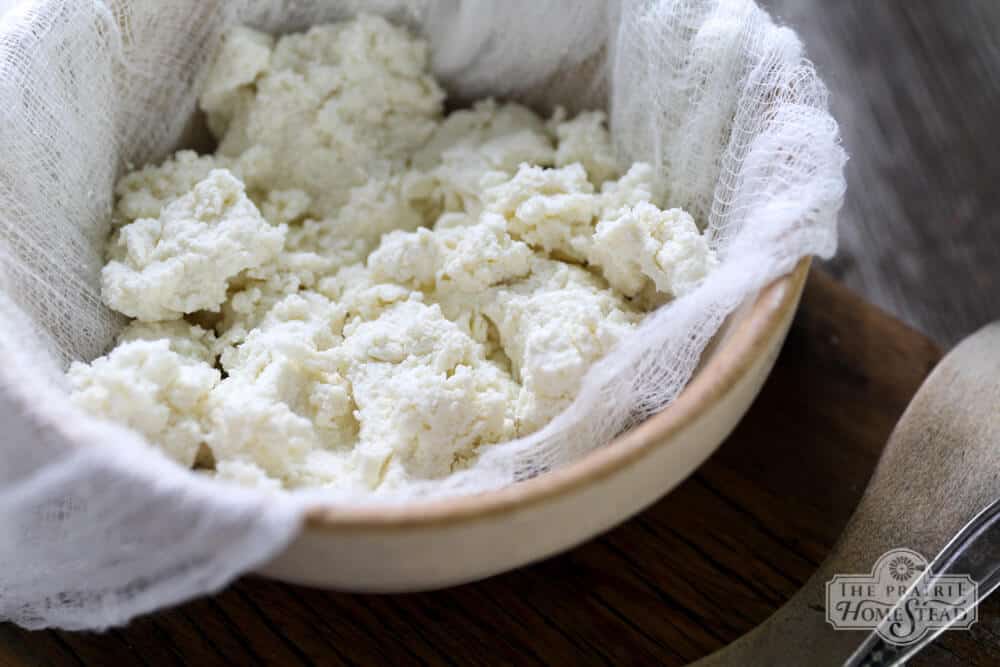 I love simple recipes that make me feel like a rockstar…
I love simple recipes that make me feel like a rockstar…
And homemade ricotta cheese definitely fits the bill.
Ricotta is one of the easiest cheeses to make, but it can transform a ho-hum recipe into something special–plus I always feel a extra fancy when I use it.
Oh, and making lasagna with homemade mozzarella AND homemade ricotta cheese? It takes the dish to a whole new level folks… If you are serving it to dinner guests–they’ll go away impressed–promise. (Especially if you pair with it a hot loaf of homemade French bread. On second thought, scratch that. You don’t want to overwhelm them with awesomeness…)
**I love New England Cheese making Supply Co. for all of my cheese making needs. They’re truly just a great company with great products, and I love supporting their small business whenever I can. They’ve also offered my readers 10% off and order with the code HOMESTEAD for a limited time.**
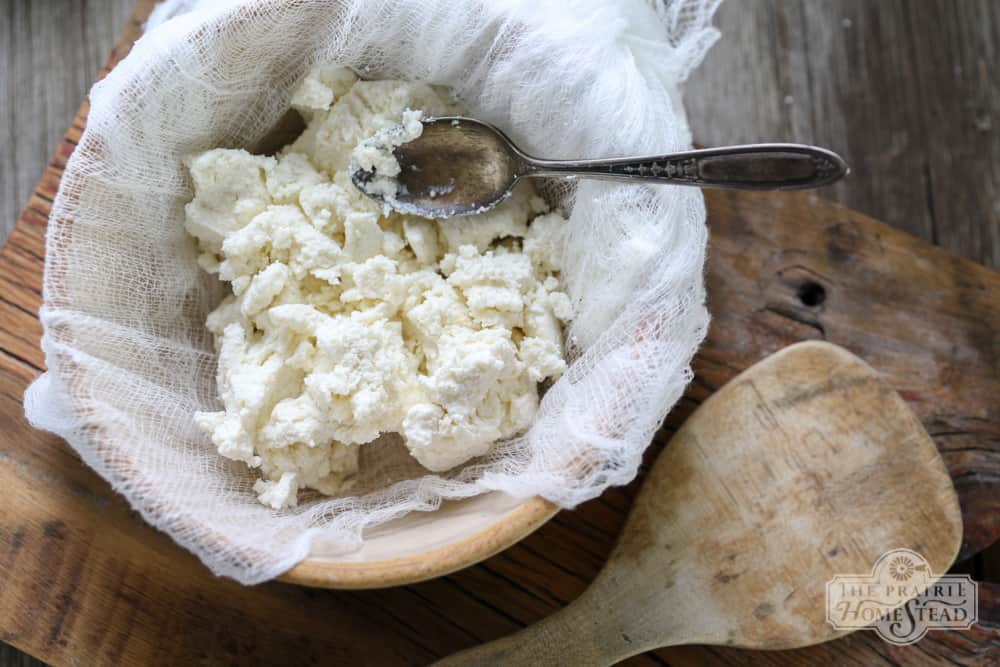
True-blue, authentic ricotta cheese simply comes from heating up whey–the word ricotta actually means “recooked.” If you’ve read my blog for a while, you are probably already intimately familiar with whey and how to use it. However, if you’re new, but sure to check out my list of 16 Things to do With Whey and my knock-your-socks-off Vintage Lemon Whey Pie recipe.
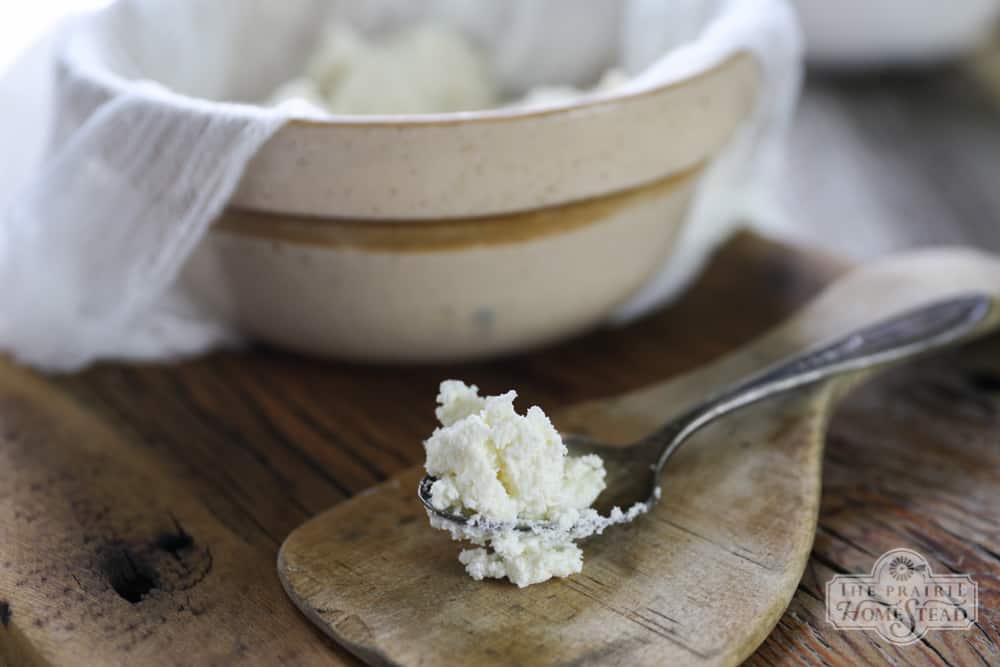
Ricotta made just from whey tends to have a low yield… So if you prefer a recipe with a slightly larger end result, try a ricotta cheese recipe that starts off with whole milk. (I’ve included that below as well!)
There seems to be approximately a million-and-one different ways to make ricotta, so if you’ve made it before, it’s likely that your method is different than mine. But I’m going to venture to say, that as long as you end up with those amazing little fluffy white clouds of ricotta goodness, there really is no “wrong” way to make ricotta.
So on to the recipes!
(this post contains affiliate links)
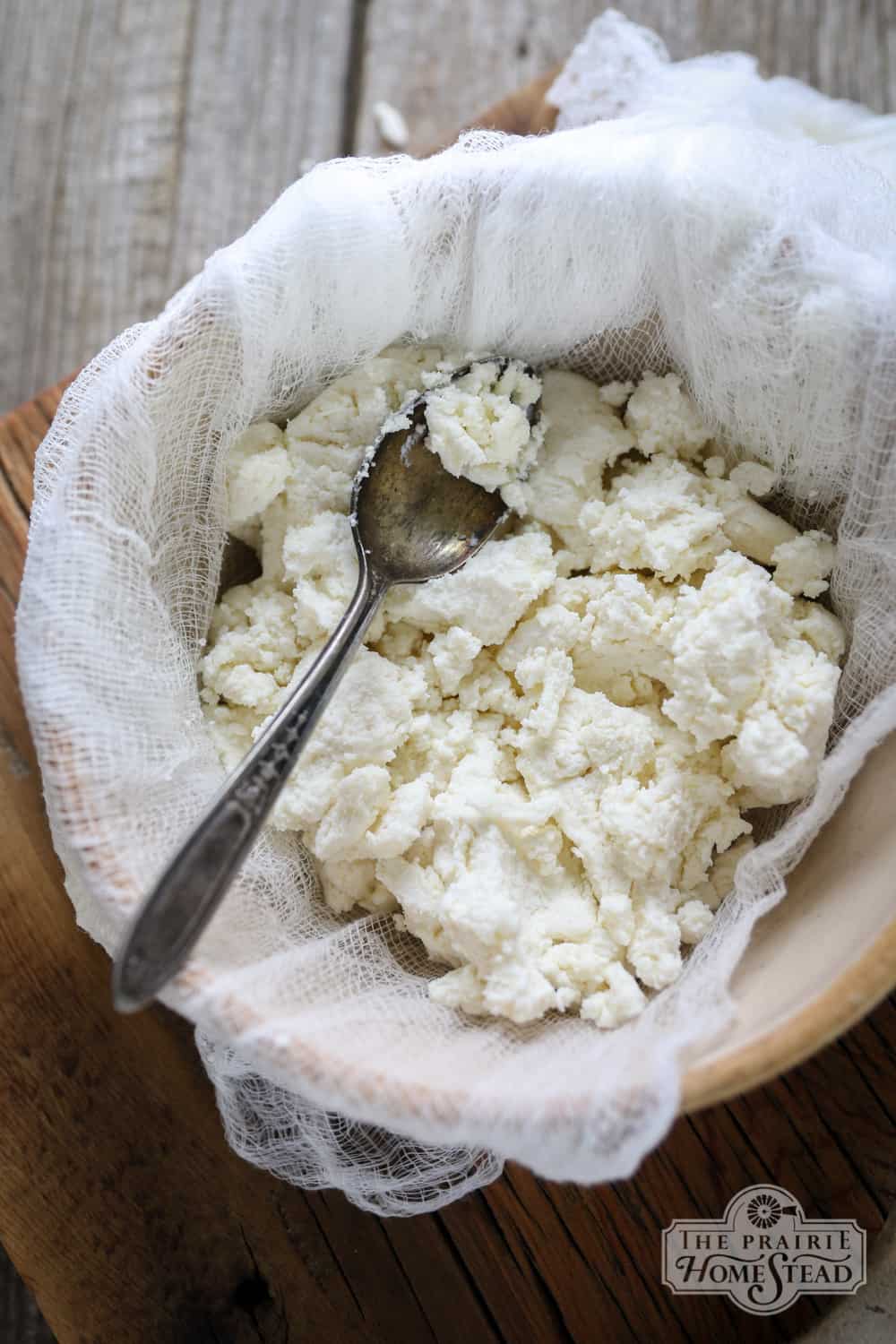
Ricotta Cheese Recipe #1 (using whey)
You will need:
- Fresh whey*, leftover from making cheese (try to use it the same day)
- Butter muslin (like this or this one is great too) OR a tea towel OR my frugal cheesecloth alternative OR a fine mesh reusable coffee filter
*This can be done with any amount of whey, but keep in mind the yield is quite small, so I don’t recommend doing it unless you have around 1-2 gallons of fresh whey at your disposal.
Instructions:
Place the whey in a large stockpot, and place it the stove over medium-high heat.
Bring it to around 190-195 degrees–or until you see fluffy looking “clouds” separating from the yellow whey when you stir the mixture. (I use a regular old ladle, but I gotta get one of these nice slotted ones for scooping curds. And this is a great thermometer if you’re in need of one.)
Avoid boiling if you can–it tends to give it a bit of a funny taste–plus it boils over easy, and cleaning sticky, cooked-on whey off your stovetop is a nightmare.
Once you see that the fluffy white ricotta cheese clouds have separated from the yellowish whey, remove it from the heat and pour it through your fabric or strainer to drain.
Allow the teeny ricotta curds to drain until all the whey has dripped out (I usually leave it for about an hour–you can go longer if you wish)
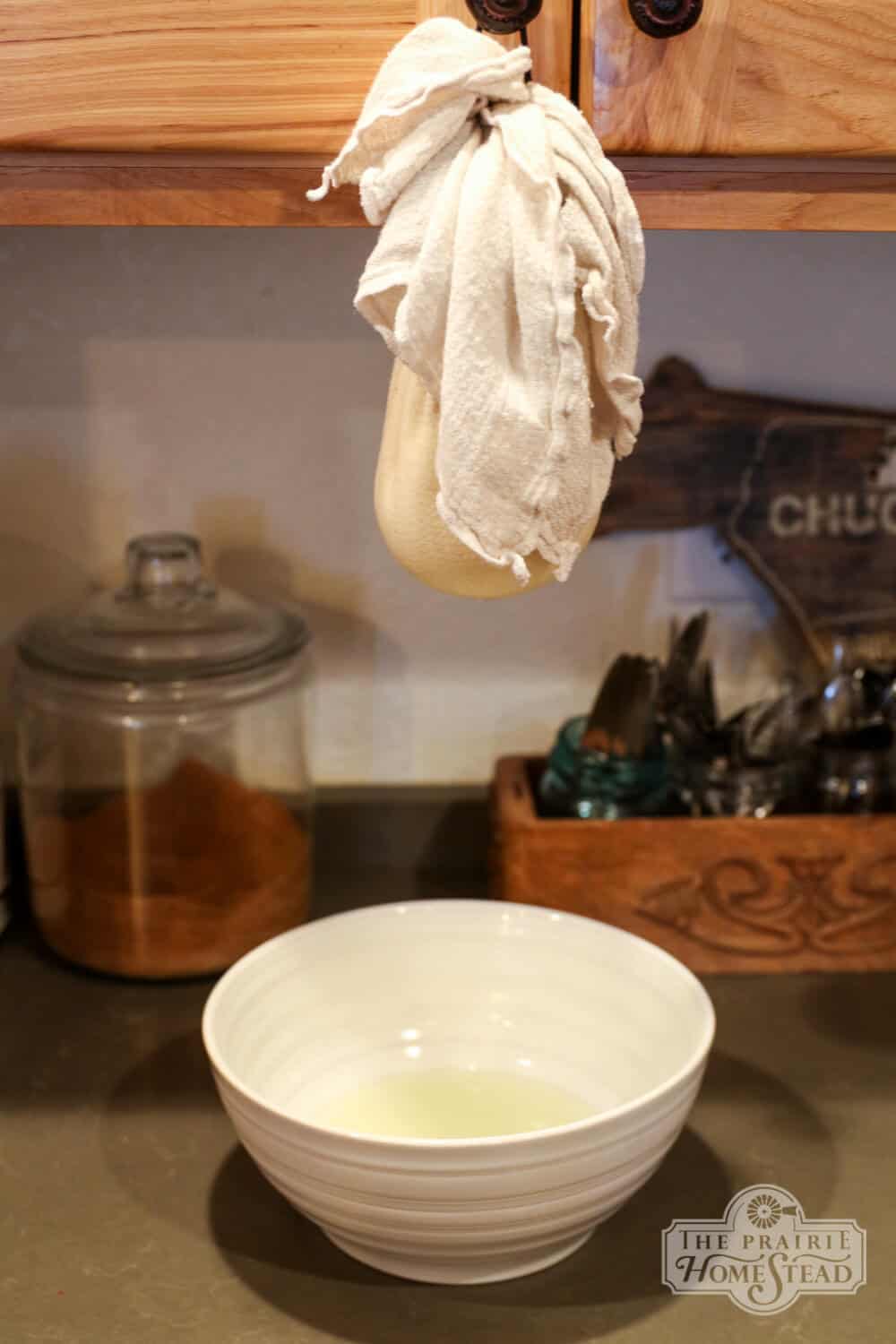
Sometimes I tie my cheesecloth/fabric into a “bag” and let it hang from a cabinet knob–other times I just line a colander with the cheesecloth and allow it to drip in the sink.
Store your fresh ricotta in the fridge or freeze it for later.
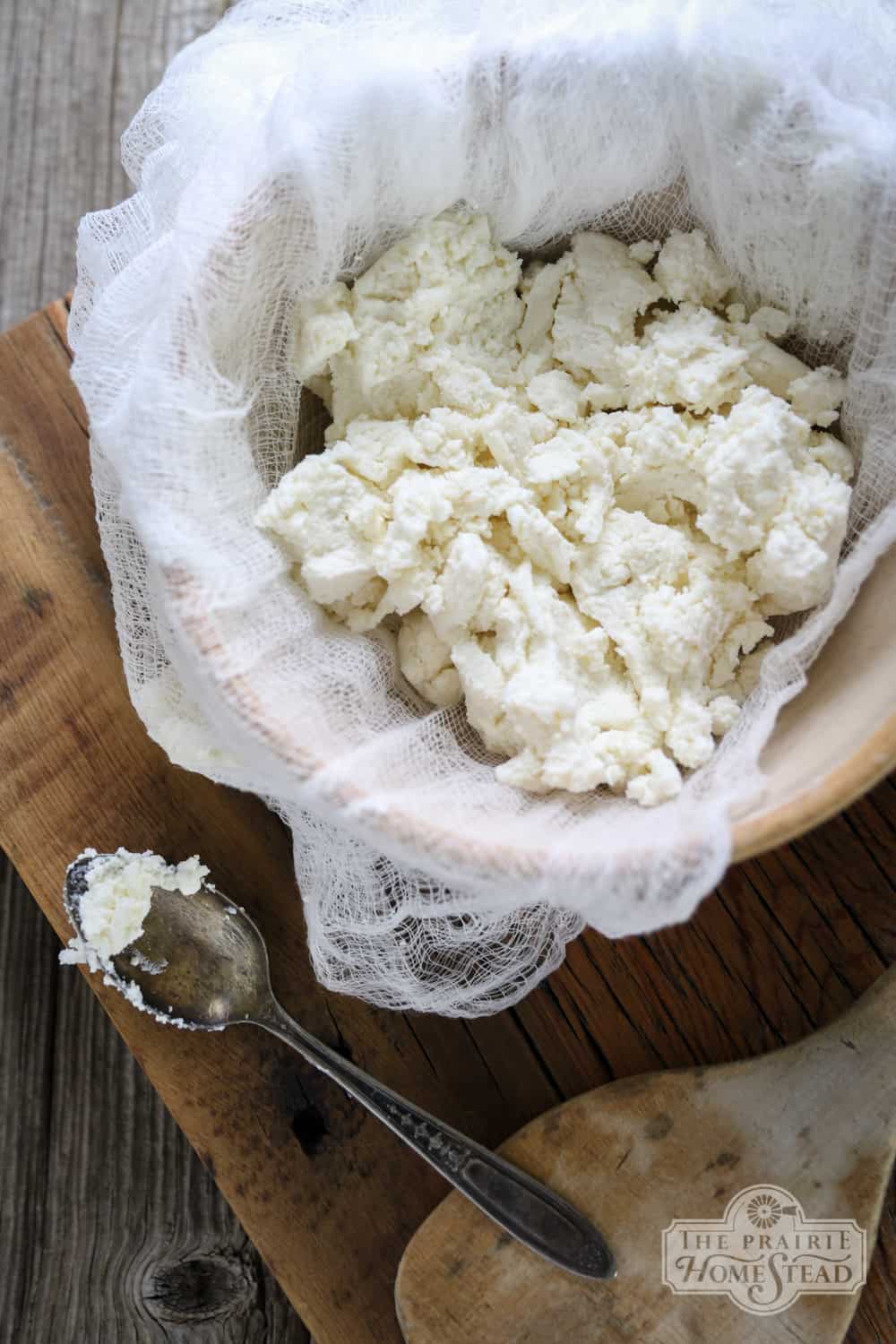
Ricotta Cheese Recipe #2 (using whole milk)
You Will Need:
- 1 gallon of whole milk
- 5 teaspoons of lemon juice (see note below)
- 1 teaspoon salt (I love and use this one)
- Butter muslin (like this or this one is great too) OR a tea towel OR my frugal cheesecloth alternative OR a fine mesh reusable coffee filter
Instructions:
Place the gallon of milk in a large stockpot and heat it over medium heat.
Once it has reached 190-195 degrees, remove it from the heat and stir in the lemon juice.
Allow the milk to sit for 5-10 minutes and wait for the curds to form.
Once you see those lovely, fluffy curds, drain the whey as directed in the whey ricotta instructions above.
Store in the fridge, or freeze for later.
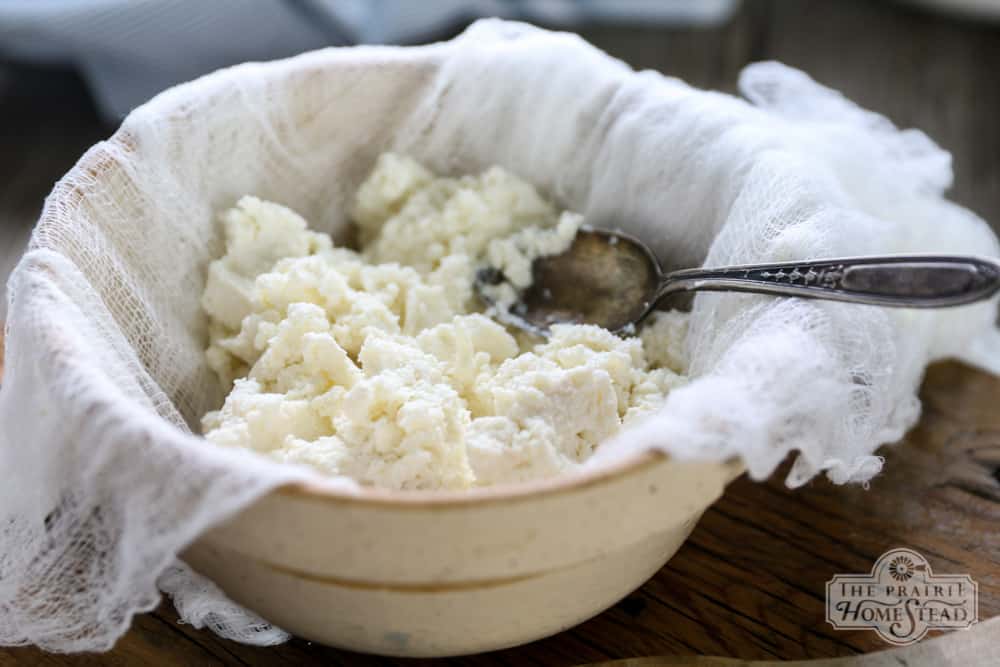
Kitchen Notes
- Lemon juice isn’t your only option for creating curds. Some people prefer 1/4 cup of vinegar, while others add 1 teaspoon of citric acid. Feel free to play around a bit–as long as you end up with curds, you are on the right track.
- Keep in mind that heating the whey for these recipes kills most of the good bacteria, so it will only keep for about a week–unless you freeze it.
- If you don’t see curds right away, try adding a bit more lemon juice, or heating a bit more on the stove. It’s really hard to mess this up–so even if the recipe doesn’t go exactly as described, it’s likely you can still salvage it and end up with some sort of ricotta-like curds.
- The whole milk ricotta cheese recipe will yield more than the whey ricotta cheese recipe.
- You’ll end up with a bunch of leftover whey after you drain it from the curds. Here’s a whole list of how to use that whey.
- **I love New England Cheese making Supply Co. for all of my cheese making needs. They’re truly just a great company with great products, and I love supporting their small business whenever I can. They’ve also offered my readers 10% off and order with the code HOMESTEAD for a limited time.**
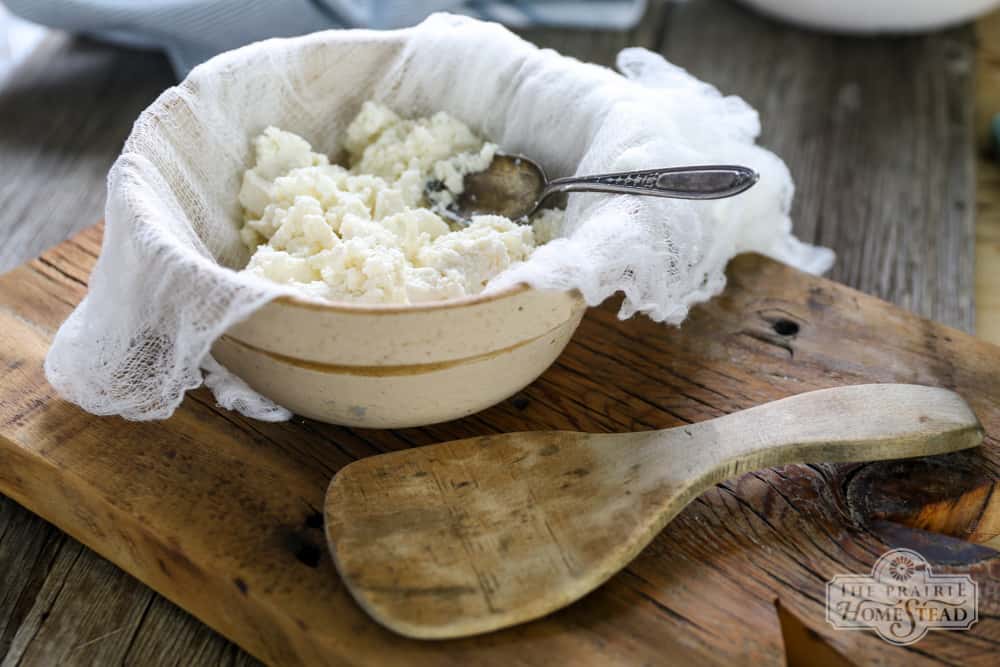
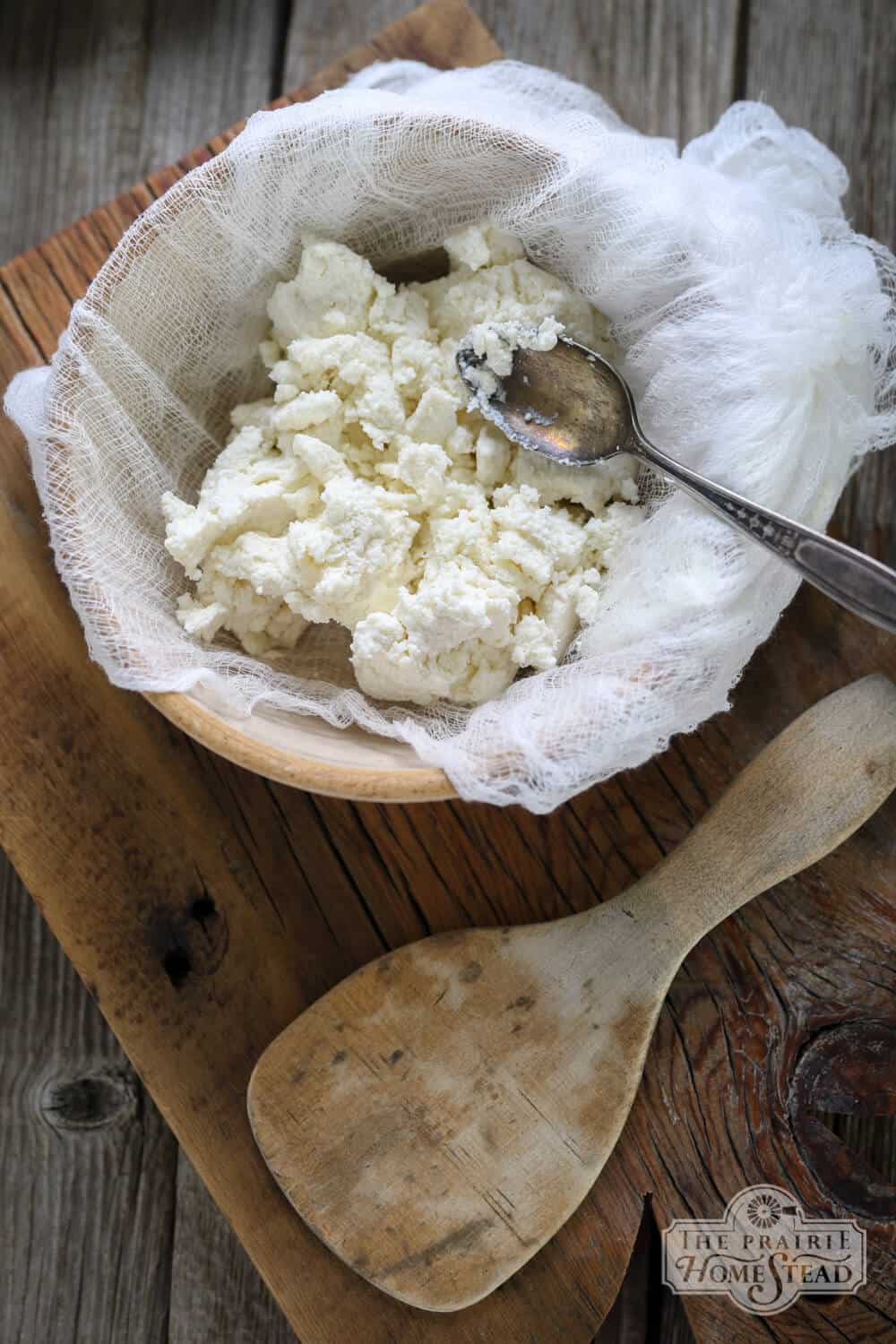
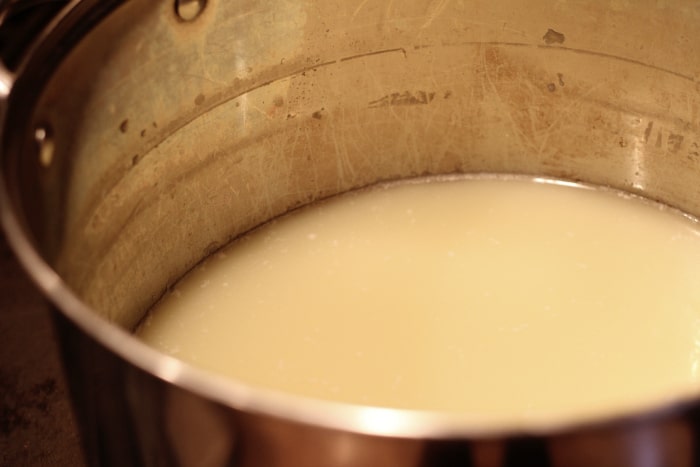
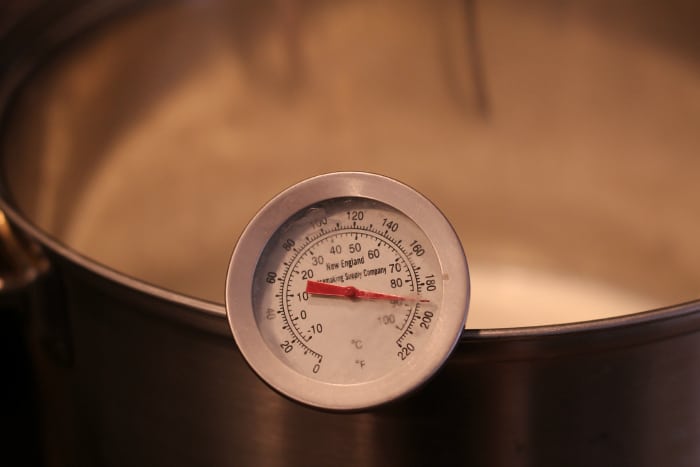
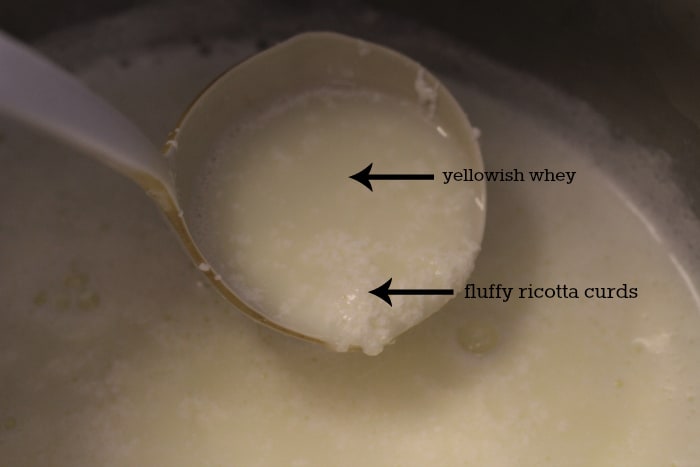
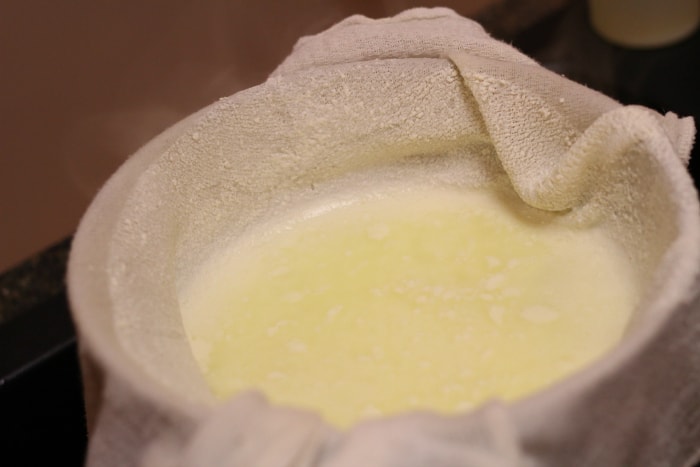

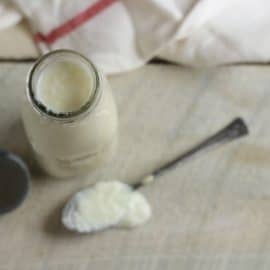
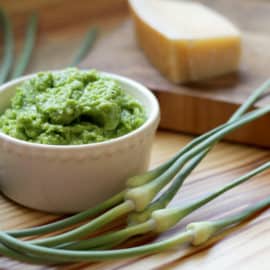
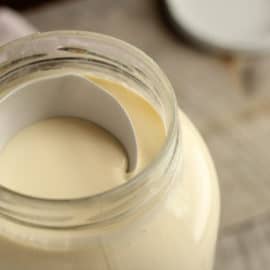
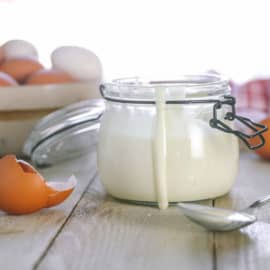
You can also add 1 quart of whole milk to your whey to increase the ricotta yield. I love making the whey ricotta because even if my cheese did not turn out perfect, the ricotta always does! I add granulated garlic, Celtic sea salt, basil and oregano to my ricotta and we love it on everything.
YUM!
Here’s a crazy question: If I make whole milk ricotta, can I use the resultant liquid (whey?) to make whey ricotta?
Whey cheeses, like traditional, or whey, ricotta, can only be made with the whey from low-temperature cheeses like cheddar. My rule of thumb is the whey from any cheese where the milk is heated to 120 degrees or less is fine for making a whey cheese, while those heated to higher temperatures are not.
Hi can I use frozen whey? I froze most all of it after making 3% milk. Thanks.
Jacqueline
Yes– I think that’ll still work.
I have used the second method to make paneer, a type of cheese used in Indian dishes, like Saag Paneer. After you’ve drained the curd you squeeze it to make a sort of disc and then put it on a plate (still wrapped), put another plate on top and weight it down with a can or anything heavy and let it sit for about a half an hour, Then you can slice it or cut it in cubes. Mild and delicious.
Could you do this with a 2-4 L batch of kefir? I am considering trying it. I let it go a little past the sweet smelling point. My last batch of kefit came out smelling like cottage cheese. No joke! I opened a fresh store bought cottage cheese to test if it smelled the same. Oops! I was
going to cook it in muffins, pancakes and sauces just yo make sure it doesn’t go to waste.
Cool! Thanks for sharing!
I take the cubed paneer and fry it very carefully. Double delicious! Look for a shahi paneer recipe for the sauce to put it with rice.
Cheese making is on my homestead to do list. Pinning this!
so i have been making ricotta for a while out of WHOLE MILK, i never realized that it is whey that i drain from it…can i use that same whey to use in fermentation? and how long does that last?
The whey that you’ll get from my two recipes won’t work in fermentation since it has been heated/cooked. However, it’s still good for many other uses.
What other uses?
Hi Laura, I saved my whey from my homemade yogurt. I froze them in ice cube trays and then transferred into freezer bags to use for whatever. Can whey from homemade yogurt be used to make the whey ricotta ~ maybe if BEFORE it was frozen? OR since it was a heated process already One time it will not work for the whey ricotta? Thank you!
Jill, ooops, so sorry I called you Laura
You *should* be able to use the whey from the homemade yogurt just fine.
You have a really nice blog here. My son and I are very interested in anything about self-sufficiency, so much so that we just published a book and have another one coming out soon.
Being able to make your own cheese is a great way to use that extra milk homesteads often have and fresh natural cheese is so wonderful
Awesome! Talking about a “cheesecloth, I found flour sack cloth in the dish rag area at Walmart. They are pretty cheap. Like a pack of 5 for $4-5. I actually got them to cut in quarters and then stitch the two sides where I cut for an alternative for paper towels/napkins. Now I’m thinking “Hey, there’s me a cheesecloth! “
I use them to strain whey from my yogurt. They work great.
Hi there I was wondering if I could use buttermilk.
I use a gallon of whole milk, a cup of half and half, a cup of buttermilk, a half cup of lemon juice and a tablespoon of sea salt for my
Ricotta. It tastes great and has good texture.
Hello, I make alot of greek yogurt and I’ve tried to make ricotta from the whey but I get very little curdling.
Am I understanding that it’s because I’ve already heated it up to 180 degrees ?
Thank you for your information.
I’m wondering the same. No way I’m getting any curdles from only whey ?
I’ve tried two different batches whey, one from yesterday and one from a couple of days back. I gave up and threw in some milk to at least get some curdles, but I doubt I will try this again. Sad, since I get so much whey, and one can only bake so much… What did I do wrong?
same thing happened to me…first recipe does not work in instant pot. Got no curds…maybe because I used such a fine cheesecloth to drain the whey from my paneer resulted in no residual curds possibly needed to multiple or instant pot saute setting too high and killed culture.
Perhaps you are using a reactive stockpot.
great site, and good posts. i love the old ways. im sick of store food.
i’ll give the cheese making a try . i freeze the goats milk and have 4 gallons. i’ve put this off long enough. but my rule is never through anything away. soo after i make more cheese out of the whey i suppose i feed it to the chickens.
We buy our raw goat milk 12 half gallon containers at a time because it’s an hour’s drive. Now i am looking into what else to do with the raw goat milk. Yogurt, kefir, ricotta cheese, sour cream, buttermilk, cottage cheese, cheese! So many choices! So glad I am retired and living in Florida! lol
I put my whey into sealed mason jars & store in the fridge. I notice your recipe says to use Fresh whey but there’s no way I’d have a gallon of whey in a day! How long is the whey good to use to make cheese or is this a lost cause for me?
It will last a good week or more in the fridge, in my experience.
Maybe if you use a cold start yogurt?
hi! i was interested in making homemade mozzarella… with the leftover whey can i immediately make this ricotta? and then use whats leftover from that for bread and whatnot? thanks! not sure how well it will work since it will be reheated so many times…
It depends on the type of mozz you make, but yes, you should be able to make ricotta from it. And then you can use the leftover whey from the ricotta in bread recipes, etc.
can i use frozen cream to make frosting?
Can I freeze my yogurt whey until I get a few gallons and then make ricotta from it still?
Yep- that should work.
I made cottage cheese from 1 cup of my homemade kefir to 2 quarts whole milk (no vinegar or lemon juice or anything else added) I heated it only to 100 degrees. Would the whey be acidic or sweet?
When speaking about degrees, this is F, nu C ?
Not C (my smartphone grrr)
It’s F
Hi Jill, thank you so much for your information! I have recently mastered making homemade yoghurt in my slow cooker and it’s been the best Greek yoghurt I have ever made. I don’t really have to drain it because once I put it in mason jars and refrigerate it is incredibly thick. However I do like taking an entire strainers worth of it and drain any liquid I can get from it through cheesecloth and it turns into an incredible thick “something”. I don’t know exactly what to call it, it’s kind of like a thick cream cheese, it has a very sweet taste I think because they whey that is drained from it is the sour part? I’ve been collecting my whey in mason jars and have several jars approximately 6 jars, I am going to try making ricotta cheese I thought I would add 2 litres of whole milk because the whey seems to be really yellow and almost translucent like there would be very little curds that would come from boiling it. I could be incorrect in my assumption but your whey looks to be more cloudy then mine. Perhaps you are using raw milk? I don’t live on a farm so I can’t access raw milk, only pastuerized milk. Finally my question….Do you think I will get ricotta cheese if I add the whole milk and my approximate 3 litres of whey (funny that you call it sweet because I always thought it was very sour and thats how I get the thick yoghurt that I don’t know what to call ). Again thank you for your information and inspiration! Do you think I will get ricotta cheese or would I be better off using the whey for something else like biscuits? (I heard it can be used as a substitute for buttermilk?)
I wish to express thanks to the writer just for rescuing me from this condition. Because of surfing around throughout the the net and finding tricks that were not beneficial, I figured my life was well over. Being alive without the solutions to the difficulties you’ve sorted out through the blog post is a crucial case, as well as the ones that would have negatively damaged my entire career if I had not noticed your web blog. That knowledge and kindness in touching everything was important. I don’t know what I would’ve done if I hadn’t come upon such a point like this. It’s possible to at this point look ahead to my future. Thanks for your time very much for your specialized and effective help. I will not hesitate to recommend your site to any individual who needs to have guidelines about this area.
I made fresh mozzarella last week and have two half-gallon jars of whey which I have kept in a very cold refrigerator. Is the whey too old to make ricotta with?
THANKS! I saw your other 16 suggestions for using whey but this and using it to water the garden were the only two I could use in my kosher kitchen. p.s. my Gjetost recipe specifically says not to use the whey from cheesemaking. Different strokes I guess.
why the step is sooo similar with the cottage cheese recipe i just tried last month?
are we talking about whole milk pasteurized (from the grocery store) or does it have to be raw milk for the ricotta?
I believe you can use grocery store (pasteurized) milk for ricotta
just to be clear, when making the ricotta from (yogurt) whey, you do NOT add any lemon/vinegar etc.? I wasn’t sure from the instructions.
Made ricotta with whole milk, froze the whey. Can I use it to make new ricotta?
Thanks
This is interesting.
This morning woke up to daughters complaining about “chunks in the 2% gallon of milk”
I tasted it and it was sweet and delicious. Wife said throw it out.
I was googling why milk curdles.
I found the ricotta cheese recipe and tried it.
I was heating up the milk and the cords got big and beautiful when the milk was only at about 105 degrees and no sticking to the pot.
I removed the curds with a ladle and poured the whey over the mixture in the sieve, collecting the why underneath. Paper towels work wonderfully as a cheesecloth substitute. Absolutely no mess.
The cheese is outstanding. I ate a lot of it before I put the rest in the fridge.
You didn’t say when to put the salt, I assume it’s to be added with the milk.
Could you add the ability to print instructions like your other recipes?
If I opt to strain yogurt at the end to make it a bit thicker, can I use the whey that I’ve strained off to make ricotta?
i had a gallon of raw milk, did not want to use raw milk for making mazzola cheese so i put the raw milk in a crock pot and raised the temp slowly to 162 degrees no worry about scorching put the hot milk in an ice cream maker and cooled it down to 50 degrees and in the frig overnite now i have pasturize milk to make mozzala cheese
Since all but one of your list of Uses for Whey is for sweet whey, what can we do with this acid whey left from making ricotta? Can it be used to soak grains? Make homemade mayo or ketchup last longer in the fridge? Is it used in the same ratio as the sweet whey?
I tried this with fresh whey and nothing happened
HELP
I tried the whey from my yogurt made using the ‘boil’ method. After straining, the whey was very clear yellow. I heated the whey to 195+ but no curds formed. I think the whey must be cloudy in order for the ricotta to form. Too bad. I was looking for something great to use the whey for. Not much of a baker so unlikely to use the whey for bread or anything.
Can you use the whey drippings left over from ricotta version 1 for baking or any other use?
My plans were to make cottage cheese from a recipe I have which looks similar to your Ricotta Cheese Recipe #2. I have made this before using raw whole milk that has not soured. This time the milk turned soured and I wasn’t sure if I was going to still be able to make this cottage cheese. I heated it a little bit and realized that it was turning the cream on top into stringy cheese. It didn’t do this before, wasn’t sure if I should save that cheese or go on with the recipe. I went on with the recipe, heated it to 180/185°, added the apple cider vinegar. I still had the stringy cheese but it seemed like I had less now. I saved the cheese, and put the rest of the liquid in jars. That liquid ended up separating. What do I have at this point? What is on top and what can I do with it? Am I still able to make ricotta with this?
Hello,
This is my first time making ricotta cheese. I am using the whole milk option. You list SALT as an ingredient but don’t see when to add it to recipe. Am I missing something? Thank you
Can I make ricotta from whole milk and then use that whey to make more ricotta? Can I use whey that has been frozen to make ricotta? Thanks!